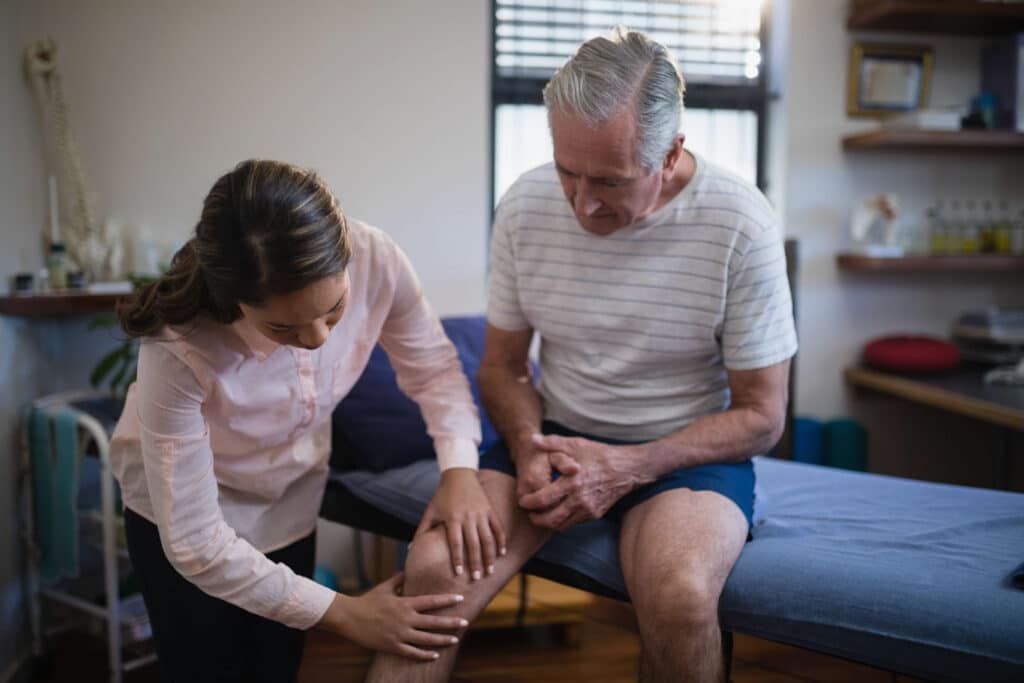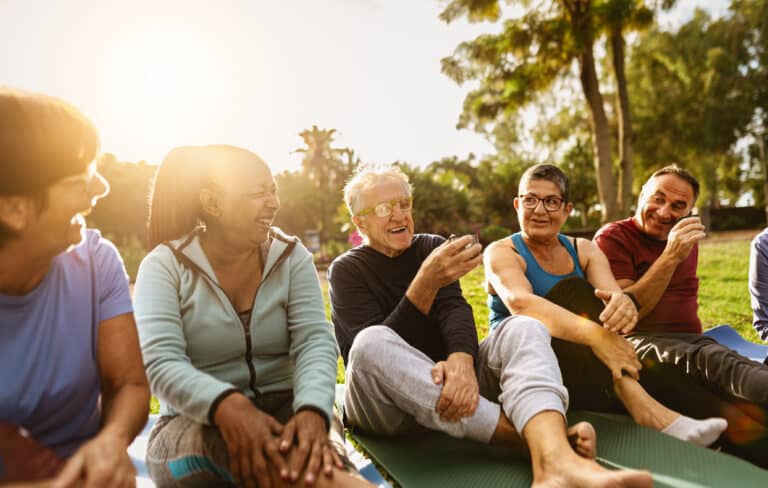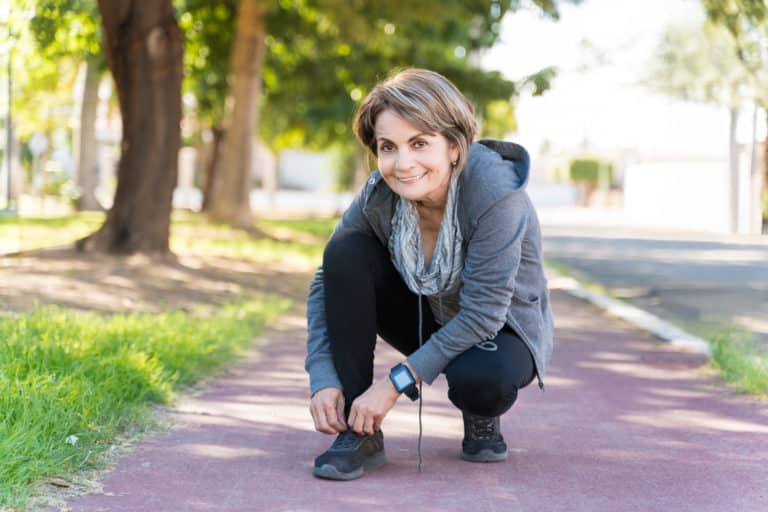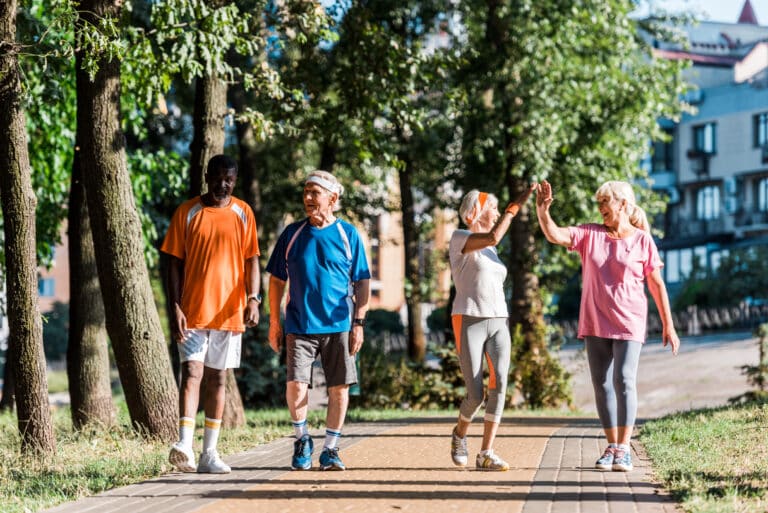Osteoarthritis of the knee affects about 37% of people over sixty in the United States. Joint pain in the knee can make everyday tasks harder, limiting physical function and increasing your risk for other problems.
However, there are many simple knee osteoarthritis exercises to manage your symptoms and reduce pain to maintain your lifestyle. This article will explore several options for non-surgical treatment of knee osteoarthritis.
What is Osteoarthritis of the Knee?
The gradual wearing down of cartilage, bone, and other tissues in our joints over time often leads to osteoarthritis. To some extent, we can think of this gradual wearing of our tissues as part of “normal aging.” Yet, osteoarthritis does not always mean “pain,” and the rate of progression and severity of symptoms can vary from person to person.2
There are three areas where osteoarthritis of the knee– and knee pain– will typically develop:
- The inside of the knee (known as the medial line)
- The outside of the knee (known as the lateral line)
- Where the kneecap meets the thigh bone (the patellofemoral joint)
Medial compartment knee osteoarthritis affects the inner knee and is usually where knee osteoarthritis is first detected.
Tricompartmental knee osteoarthritis refers to degeneration in all three locations at once.
What Are Some Common Knee Osteoarthritis Symptoms?
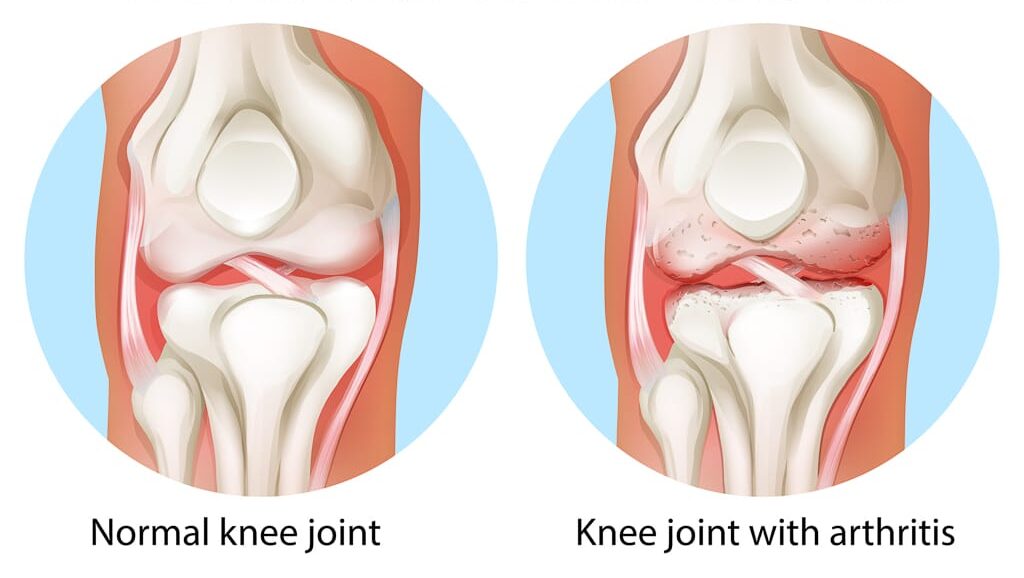
Many people with knee osteoarthritis may not experience symptoms at all. One study looked at MRIs of people with no knee pain, yet found knee osteoarthritis present in 19-43% of people over forty.3
Conversely, many people with even mild to moderate OA will experience symptoms like joint stiffness, loss of mobility, pain, and swelling. These symptoms can lead to decreased activity to avoid or lessen pain intensity.
When you are less active, your muscles weaken, leading to more stress and strain on the joint. This can be a frustrating cycle, but let’s look at some simple exercises to reverse this slow decline so you can regain physical function in your knees.2
Exercise-Based Options for Knee Osteoarthritis
Knee osteoarthritis treatment options include exercise, physical therapy, weight loss, knee braces, medications, and injections. There are also a handful of daily habit changes that can come in handy. Adding light aerobic activities, like walking with friends, can be helpful. Getting plenty of sleep is also important to nourish and strengthen your body.
Let’s look at how good movement and exercise can help prevent or manage your knee pain.
How Can Knee Osteoarthritis Exercises Help?
One study found an 80% reduction in pain following exercise-based programs for knee osteoarthritis! These programs averaged three 30-minute sessions per week for eight weeks.4
It’s best to avoid high-impact activities like running if you are feeling joint pain in your knees or hips. As pain levels subside, returning to these activities is possible if it is within your personal goals.
Needs and preferences will vary, so it may be best to seek aid from a physical therapist before beginning any program to manage knee pain.
Here are a couple of simple ways to get started:
Strengthening for knee pain
Strength training for knee osteoarthritis should focus on the thighs and the muscles around the outer hip. The goal is to create greater knee stability and shock absorption during movement. Increased strength in the quadriceps has been linked to reduced cartilage loss in the knee joint. 4
Here are a couple of simple exercises you can try at home to begin strengthening the large quadriceps muscles in your upper leg:
Straight Leg Raise
The straight leg raise is a common beginner’s quadriceps muscle strengthening exercise:
- Start by laying on your back with your leg straight before you.
- Squeeze the muscle at the front of your thigh and lift your foot off the floor about 18 inches while keeping the knee straight.
- Repeat this exercise for several repetitions until you feel fatigued in the thigh.
Sit to Stand
Strength exercises can also imitate daily activities such as standing from a chair. Note, if this is difficult for you because of knee pain, start by sitting on an extra cushion or pillow to increase the height of your chair:
- Practice going from sitting to standing from this surface for several repetitions until fatigued.
- Gradually lower the height as you get stronger.
Mobility for Knee Pain
Other exercises can help with improving your range of motion. As arthritis progresses, bending or straightening your knee may become more difficult. For this reason, it is important to move your knee through your full range of motion as often as possible.
Here are a couple of mobility exercises that target the muscles around your hip and thigh to lessen knee osteoarthritis and knee pain:
Heel Slides
- While laying on your back, bend one knee as much as possible without causing pain.
- Hold at the deepest part of the stretch for a few seconds, then extend your knee back out straight.
- Repeat this exercise for up to ten repetitions at a time, a few times per day, especially after periods of inactivity.
Standing Hamstring Curl
The standing hamstring curl is another great exercise focusing on knee mobility and strength.
- Start standing, holding on to a steady surface if needed for balance, and bend your knee, as if trying to kick your heel to your butt.
- Pause at the point where you feel a strong engagement at the back of your thigh, then lower and repeat until you feel slightly fatigued.
Body Mechanics
Knowing how to move your body is another key component in managing knee osteoarthritis to maintain ideal physical function and reduce pain.
Poor body mechanics can hurt the movement, potentially leading to pain in other related joints, such as the opposite knee, the hips, or the back. Likewise, good body mechanics can help relieve stress on the knee joint and offer relief.
Body mechanics are also important with other common activities like squatting and lifting. When squatting, for example, allowing your knees to move forward past your toes can cause knee pain and eventual injury. If you have knee pain, shifting your weight back during your squat may be better to avoid this stress.5
If you are limping due to knee pain, a cane may help you maintain daily physical function with extra support. This change may only be necessary for walking longer distances and can be temporary until symptoms are better managed.
Other Non-surgical Treatments for Knee Osteoarthritis
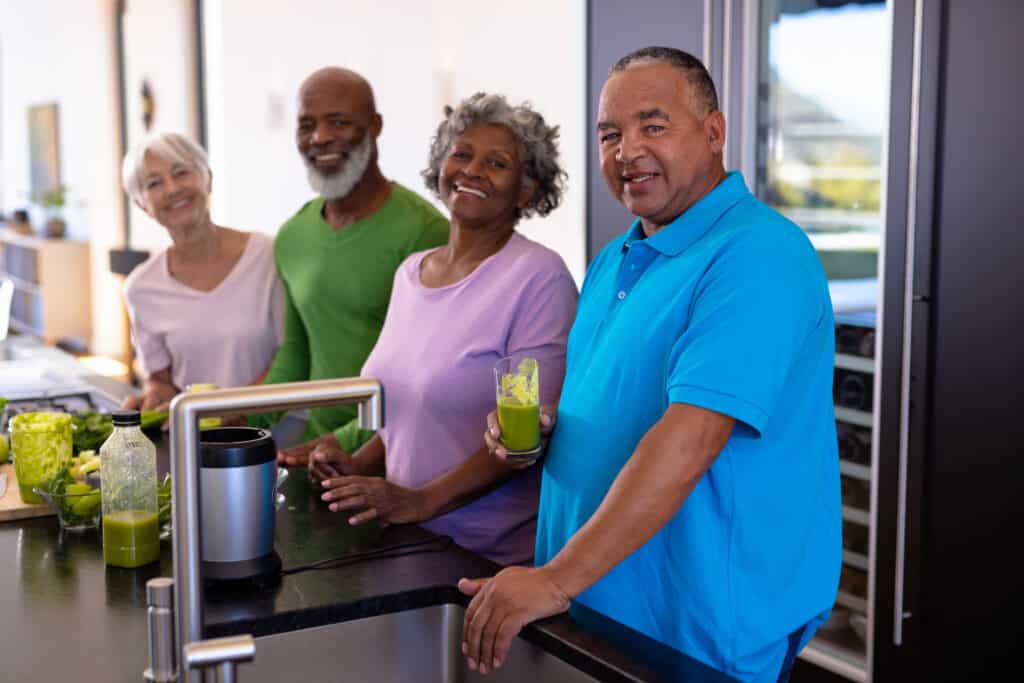
Weight Loss
Weight loss should be one of the first things to consider for knee osteoarthritis. Force absorbed by your knee joint can be up to six times your body weight, based on your activity.4
Losing only ten pounds could reduce the impact on your knee joint by 30-60 pounds, reducing knee pain while slowing the progression of your osteoarthritis symptoms.
Knee Braces
Sometimes, a brace will provide external support to remain active and reduce the risk of further injury. Many knee braces or sleeves compress the joint to help reduce or manage swelling.
Neenca Compression Knee Sleeve
If you have a nagging knee pain that you want to protect from getting worse, you may benefit from wearing a compression brace with lateral support. This type of brace can reduce inflammation, improve blood flow, and provide some stability for your knee. Just remember this is a “comfort fix”, not a long-term solution. You’ll still want to follow up with your physical therapist for exercises and other therapies that can help you manage your pain and prevent further damage to your knee.
The highly rated Neenca Compression Knee Sleeve is the brace we most often recommend to our patients.
Our recommendations are the same items we trust and prescribe to patients. When you buy through links like this on our site, we may earn an affiliate commission to support new content.
Heat or Cold
Heat or ice modalities can also help manage short-term pain. These should be used in addition to other treatments and not as a stand-alone treatment. Apply for 15-20 minutes at a time. Closely watch the temperature and your skin to avoid burns.
Please note that you should not use either of these methods if you lack sensation around your knee.
Talk to a Healthcare Professional
Finally, there are many things your doctor and/or physical therapist can do to help you manage knee osteoarthritis. It is always best to contact your healthcare professional if your pain is beginning to interfere with your daily life.
Physical Therapy
Physical therapy can be beneficial for managing knee osteoarthritis and many other common conditions. A physical therapist will analyze your movements and determine the best treatment for your knee pain. Your PT will focus on careful exercise selection and prescribing the proper amounts to match your ability and needs.
Exercise is very important for improving symptoms of knee osteoarthritis, but the exercises must also be the right fit for you. A physical therapist will help you find a starting point and provide meaningful progressions as you become stronger.
Treatments may also include ultrasound, manual therapy, or dry needling. These techniques can help improve your range of motion and provide short-term pain relief so you can get back to doing what you love.
Injections
Your doctor might also recommend intra-articular (inside-the-joint) injections in certain cases. These may include corticosteroids, hyaluronic acid, and platelet-rich plasma.
These treatments have pros and cons, and some may not be an option for all patients with knee osteoarthritis.
Injections for knee osteoarthritis are usually utilized to help reduce pain and inflammation in the joint. The length and amount of relief can vary between patients and injection types. Injections are best utilized as an adjunct to other treatments to maximize your results.
Steroid injections help to reduce inflammation in your knee and are designed to provide short-term relief. Due to the potential side effects of long-term steroid use, the number of injections you can receive is typically limited.6
Hyaluronic acid is a naturally occurring substance in healthy joints. Since it assists with lubrication and shock absorption, this injection can help restore knee function. Hyaluronic acid can also aid in lessening inflammation. Results vary for these injections, ranging from several months of relief to no change. Hyaluronic acid injections also tend to be expensive.6
Platelet-rich plasma (PRP) injections are developed and modified from samples of your blood. Platelets assist in preventing the progression of osteoarthritis to reduce pain and potentially assist with the regeneration of cartilage. Success is mixed, and more research is necessary to determine the overall effect of these types of injections on patients with knee osteoarthritis.6
Key Takeaways
- Knee osteoarthritis is a common condition affecting a significant portion of adults over sixty, leading to joint pain and mobility issues.
- Non-surgical treatments focus on symptom management and improving joint function, including exercise, weight management, and lifestyle changes.
- Exercises to strengthen and increase mobility, especially around the thighs and hips, effectively manage knee pain and enhance joint stability.
- Weight loss can significantly reduce knee joint stress, helping to alleviate pain and slow the progression of osteoarthritis.
- Using knee braces and applying heat or cold can provide external support and manage short-term pain.
- Physical therapy is beneficial for tailored exercise regimes and may include other treatments like ultrasound, manual therapy, or dry needling.
- Intra-articular injections such as corticosteroids, hyaluronic acid, and platelet-rich plasma can reduce pain and inflammation, but their effects can vary.
- Consulting healthcare professionals, including doctors and physical therapists, is crucial for personalized treatment plans and managing osteoarthritis effectively.
References
- Kawano, M. M., Araújo, I. L., Castro, M. C., & Matos, M. A. (2015). Assessment of quality of life in patients with knee osteoarthritis. Acta ortopedica brasileira, 23(6), 307–310. https://doi.org/10.1590/1413-785220152306150596
- Osteoarthritis. National Institute of Arthritis and Musculoskeletal and Skin Diseases. https://www.niams.nih.gov/health-topics/osteoarthritis. Accessed November 20. 2022
- Culvenor AG, Øiestad BE, Hart HF, et alPrevalence of knee osteoarthritis features on magnetic resonance imaging in asymptomatic uninjured adults: a systematic review and meta-analysisBritish Journal of Sports Medicine 2019;53:1268-1278.
- Bhatia, D., Bejarano, T., & Novo, M. (2013). Current interventions in the management of knee osteoarthritis. Journal of pharmacy & bioallied sciences, 5(1), 30–38. https://doi.org/10.4103/0975-7406.106561
- Schoenfeld, B. Squatting Kinematics and Kinetics and Their Application to Exercise Performance. The Journal of Strength and Conditioning Research. 24(12):3497-506
- Ayhan, E., Kesmezacar, H., & Akgun, I. (2014). Intraarticular injections (corticosteroid, hyaluronic acid, platelet rich plasma) for the knee osteoarthritis. World journal of orthopedics, 5(3), 351–361. https://doi.org/10.5312/wjo.v5.i3.351

